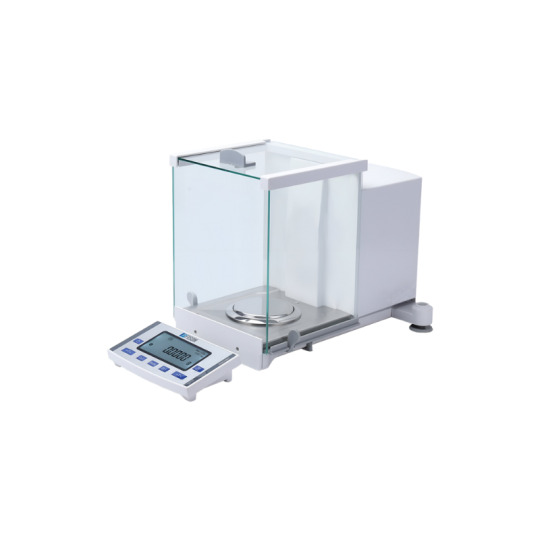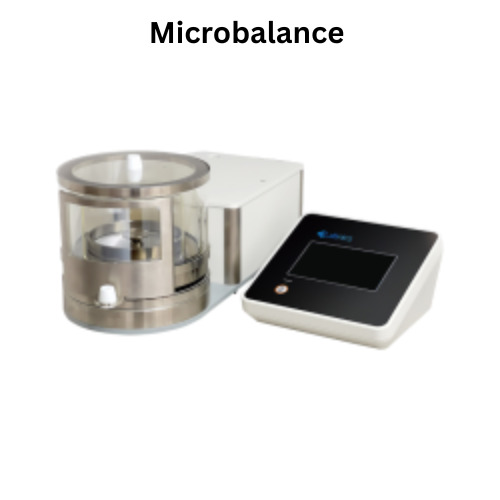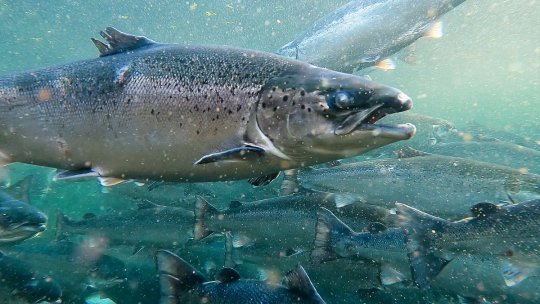#MicroBalance
Explore tagged Tumblr posts
Text
Micro-Analytical Balance FM-MAB-B100
Fison Micro-Analytical Balance offers a 120 g capacity with precision up to 0.01 mg, ensuring milligram accuracy. Equipped with advanced micro-weighing technology, anti-vibration, and overload protection, it is perfect for labs and industries,stable and error-free measurements.

0 notes
Text

Labtron Internal Calibration Analytical Balance delivers fast, accurate weighing with a magnetic sensor for stability, a 0.0001 g resolution and LCD display. It features automated calibration, a cast aluminum cover, and RS-232/RS-485 interfaces for quick data transfer.
0 notes
Text
Microbalance
Labnics microbalance is a highly precise scale that offers a weighting capacity of 6.2 g with 0.001 mg of readability and a tare weight of -6.2 g. It features automatic internal calibration, a 5-inch touch screen display, and a recipe function (GLP setting or user setting).

0 notes
Text

Aczet Micro Balance CM 21
Brand : Aczet
Model : CM 21
Readability (mg) : 0.001
Capacity (g) : 21
Stabilization Time (sec) : 7
Repeatability (mg) : 1000
Pan Size (mm) : 30
Buy : https://vegabazaar.com/product/Aczet-Micro-Balance-CM-21/
0 notes
Text
Microbalance NMB-101

Labnics microbalance, with a 5-inch touch screen, provides a typical readability of 0.001 mg and a 6.2 g max capacity. Features a tare of -6.2 g, internal automatic calibration, 10 sec stabilization, and operates in +10 °C to +40 °C with 40%-80% humidity.
0 notes
Text
Feeding all the basemicers out there😂😂😂😂😂😂😂😂😂😂😂😂(me)


+ my best friends fanart version of basemic💚💚💚💚💚💚💚💚💚(or microball.....𝒽𝑒𝒽)


24 notes
·
View notes
Text
mutual 1: i fuckign love. peanous
mutual 2: does anyone else ever wonder what the fuck people mean when they say watches are powered by quartz?? i mean it's just a rock, it's not like radioactive or anything, it doesn't Actually emit an aura, right?? right????
mutual 3: rats rats rats rats rats rats rats rats rats rats rats rats rats rats rats rats rats rats rats rats rats rats rats rats rats rats rats rats rats rats rats rats rats rats rats rats rats rats rats rats rats rats rats rats rats rats rats rats rats rats rats rats rats rats rats rats rats rats rats rats rats rats rats rats rats rats rats rats rats rats rats rats rats rats rats rats rats rats
mutual 4: [the most beautiful art of a character who spent 10 minutes onscreen in a missing 1960's doctor who episode]
mutual 5: i fuckign love. peanous
mutual 6: Piezoelectricity (/ˌpiːzoʊ-, ˌpiːtsoʊ-, paɪˌiːzoʊ-/, US: /piˌeɪzoʊ-, piˌeɪtsoʊ-/) is the electric charge that accumulates in certain solid materials—such as crystals, certain ceramics, and biological matter such as bone, DNA, and various proteins—in response to applied mechanical stress. The word piezoelectricity means electricity resulting from pressure and latent heat. It is derived from Ancient Greek πιέζω (piézō) 'to squeeze or press', and ἤλεκτρον (ḗlektron) 'amber' (an ancient source of electric current). The piezoelectric effect results from the linear electromechanical interaction between the mechanical and electrical states in crystalline materials with no inversion symmetry. The piezoelectric effect is a reversible process: materials exhibiting the piezoelectric effect also exhibit the reverse piezoelectric effect, the internal generation of a mechanical strain resulting from an applied electric field. For example, lead zirconate titanate crystals will generate measurable piezoelectricity when their static structure is deformed by about 0.1% of the original dimension. Conversely, those same crystals will change about 0.1% of their static dimension when an external electric field is applied. The inverse piezoelectric effect is used in the production of ultrasound waves. French physicists Jacques and Pierre Curie discovered piezoelectricity in 1880. The piezoelectric effect has been exploited in many useful applications, including the production and detection of sound, piezoelectric inkjet printing, generation of high voltage electricity, as a clock generator in electronic devices, in microbalances, to drive an ultrasonic nozzle, and in ultrafine focusing of optical assemblies. It forms the basis for scanning probe microscopes that resolve images at the scale of atoms. It is used in the pickups of some electronically amplified guitars and as triggers in most modern electronic drums. The piezoelectric effect also finds everyday uses, such as generating sparks to ignite gas cooking and heating devices, torches, and cigarette lighters.
mutual 7: anyone else a transgenger women on this fine wet beast wuesday
mutual 8: you know how you can pour liquid mercury into more liquid mercury and it becomes one thing of liquid mercury? why doesn't that happen with solids? why can't you place two gold bars on top of each other to make one really big gold bar? that doesn't make sense to me
mutual 9: i fuckign love. peanous
mutual 10: [30,000 reblogs of mutual 4's art]
mutual 11: who up thinkin about The Characters. i know i'm tbinking about The Characters. are you thinking abkut The Characters? you should be thinking about the The Characters
mutual 12: gideon the ninth more like giddy in the- (i am dragged offstage before you can hear what i could have possibly finished that sentence with)
mutual 13: Cold welding or contact welding is a solid-state welding process in which joining takes place without fusion or heating at the interface of the two parts to be welded. Unlike in fusion welding, no liquid or molten phase is present in the joint. Cold welding was first recognized as a general materials phenomenon in the 1940s. It was then discovered that two clean, flat surfaces of similar metal would strongly adhere if brought into contact while in a vacuum (see Van der Waals force). Newly discovered micro- and nano-scale cold welding has shown potential in nanofabrication processes.
Richard Feynman: "The reason for this unexpected behavior is that when the atoms in contact are all of the same kind, there is no way for the atoms to "know" that they are in different pieces of copper. When there are other atoms, in the oxides and greases and more complicated thin surface layers of contaminants in between, the atoms "know" when they are not on the same part." — Richard Feynman, The Feynman Lectures on Physics, 12–5 Friction
mutual 14: hey didn't you work on the manhattan project. hey y'all callout post for Richard Feynman, mutual 13 (for talking about something related to him), mutual 8 (for asking about something related to him), and mutual 7 (for being a trans woman on a post next to where all of this was happening). they're all terrible horrible unforgivable people and-
Are you sure you want to block mutual 14 from seeing your posts?
nevermind block
mutual 15: i fuckign love. boobs [breasts image]
#iloveyou.pdf#anyway. curate your dash folks#long post#always wanted to make one of these but i think i went a lil too much with it#thank you wikipedia my beloved wikipedia. i am copypasting yuo somuch 💖
9 notes
·
View notes
Text

Microballs or whatever his name was
12 notes
·
View notes
Note
16, 22, 27 and 44 please!
16. Gush about your favorite Batcher:
WHERE DO I EVEN BEGIN.... Tech wasn't even my favorite at first (it was Echo), but he quickly grew on me. i love how curious, inquisitive, and quick-witted he is, how he has a crazy plan for everything, and how he ends up opening up to others. i really enjoyed seeing his character development, it showed that not only is he the brains of the group, but he's so incredibly loving. he has a hard time talking about and showing his feelings, but he adores his family. and he's also gorgeous. like... star wars created a tall handsome genius pilot/engineer/mechanic/inventor/medic(?)/scientist/racecar driver and expected us not to be absolutely obsessed with him?? Phee is so damn lucky. also, he's definitely alive ���
22. Which Batcher do you think had the most awkward first kiss?
realistically, i don't think any of them have been kissed yet! but Tech is about the have the most awkward first kiss of all future first kisses (and i'm almost positive we will see it on screen lol). he'll freeze up and stutter and fumble through it at first, but he'll figure it out, he's a quick learner!
27. Tell me a random headcanon you have about Tech:
he's left-handed. in the show, he uses both hands for typing on his data pad, using tools, and firing blasters, but i imagine that he would write with his left!
ok another one because i can't resist: he's a terrible cook. awful. he follows every recipe TO A TEE like microbalance precision, millisecond timer, hyper-accurate oven temperature and it just never turns out right. meanwhile Wrecker cooks with taste-testing and vibes alone and his baking is immaculate. the man has never opened a cookbook.
44. Tell me an angsty headcanon you have about Echo:
it's basically fanon at this point, but Echo still has nightmares about techno union. the brief medical panic from season 1 episode 1, and him telling Omega that he doesn't like being alone (because he was alone on Skako Minor for so long) in season 2, both lead me to believe that he probably doesn't sleep well at night.
thank you, these were so fun!!! (except that last one, i want to hold him gently 🤲🥺💕)
2 notes
·
View notes
Text
weighing things on the microbalance all day is supreme torture for my delicate little shoulders i swear
1 note
·
View note
Text
Top Laboratory Equipment: Essential Tools for Accurate Scientific Research

In any scientific laboratory, having the right equipment is crucial for obtaining precise and reliable results. From basic instruments to advanced analytical systems, the tools in a lab help researchers perform experiments, analyze data, and reach conclusions. In this article, we explore the top laboratory equipment that plays a vital role in scientific research.
Spectrophotometers
Spectrophotometers are widely used for measuring the amount of light absorbed by a sample at different wavelengths. These instruments are vital in fields like chemistry, biology, and pharmaceuticals.
Key Uses:
Quantifying the concentration of DNA, RNA, and proteins.
Determining the purity of substances.
Types:
UV-Vis Spectrophotometer
Infrared (IR) Spectrophotometer
Chromatography Systems
Chromatography is essential for separating components of a mixture, and it includes a variety of systems suited to different types of samples.
Types:
Gas Chromatography (GC): Best for volatile compounds.
High-Performance Liquid Chromatography (HPLC): Ideal for separating liquid mixtures.
Thin-Layer Chromatography (TLC): For qualitative analysis.
Mass Spectrometers
Mass spectrometers measure the mass-to-charge ratio of ions and are crucial for identifying compounds, determining molecular structures, and quantifying substances.
Types:
Quadrupole Mass Spectrometer: Commonly used for quantitative analysis.
Time-of-Flight (TOF) Mass Spectrometer: Known for speed and resolution.
pH Meters
pH meters measure the acidity or alkalinity of a solution. Accurate pH measurement is vital for a range of industries, including water treatment, food, and pharmaceuticals.
Types:
Digital pH Meters: High precision for laboratory use.
Balances and Scales
Laboratories rely on balances and scales for accurate mass measurements. Analytical balances can measure down to micrograms, which is essential for preparing accurate solutions.
Types:
Microbalances: For ultra-precise weighing.
Top-Loading Balances: For general lab use.
Centrifuges
Centrifuges separate substances based on their density. They are used extensively in biological and biochemical research to prepare samples for further analysis.
Types:
Microcentrifuges: For small-volume samples.
High-Speed Ultracentrifuges: For high-density particle separation.
Thermocyclers (PCR Machines)
Polymerase Chain Reaction (PCR) machines are used to amplify DNA samples, making them crucial in genetics, diagnostics, and research.
Types:
Standard PCR Machines: For DNA amplification.
Real-Time PCR (qPCR): For quantifying DNA or RNA during the amplification process.
Atomic Absorption Spectrometers (AAS)
AAS is a technique used to measure the concentration of metal elements in a sample, including trace metals such as lead, mercury, and arsenic.
Applications:
Environmental testing
Food safety analysis
Fourier Transform Infrared Spectrometers (FTIR)
FTIR spectrometers are used to identify organic materials by measuring their absorption of infrared light.
Applications:
Pharmaceutical analysis
Quality control in material testing
X-Ray Fluorescence (XRF) Analyzers
XRF analyzers are non-destructive tools used to determine the elemental composition of materials, making them valuable in industries like mining and materials science.
Applications:
Geological surveys
Material analysis
Equipping a laboratory with the right tools is essential for conducting accurate research. Whether it's spectrophotometers, chromatography systems, or mass spectrometers, each instrument serves a specific purpose to ensure precise results. By investing in top laboratory equipment, researchers can maintain high standards of quality, ensuring their findings contribute to advancements in science and industry.
0 notes
Text

Microbalance NMB-101
Labnics microbalance is a highly precise scale that offers a weighting capacity of 6.2 g with 0.001 mg of readability and a tare weight of -6.2 g. It features automatic internal calibration, a 5-inch touch screen display, and a recipe function (GLP setting or user setting).
0 notes
Text
Cell-free expression with a quartz crystal microbalance enables rapid, dynamic, and label-free characterization of membrane-interacting proteins
bioRxiv: http://dlvr.it/T1QrWt
0 notes
Text
Tugba Turnaoglu: Integrating Advanced Materials Into Buildings - Technology Org
New Post has been published on https://thedigitalinsider.com/tugba-turnaoglu-integrating-advanced-materials-into-buildings-technology-org/
Tugba Turnaoglu: Integrating Advanced Materials Into Buildings - Technology Org
The common sounds in the background of daily life – like a refrigerator’s hum, an air conditioner’s whoosh and a heat pump’s buzz – often go unnoticed. These noises, however, are the heartbeat of a healthy building and integral for comfort and convenience.
As a chemical engineer and researcher at the Department of Energy’s Oak Ridge National Laboratory, Tugba Turnaoglu is tuned in to the rhythm of building equipment, not just hearing the whirs, but envisioning the liquids flowing within equipment that keep conditions cool or warm, as needed.
Building with advanced materials – illustrative photo. Image credit: Pixabay (Free Pixabay license)
In her three years working within the Thermal Energy Storage and Multifunctional Equipment Integration groups, Turnaoglu has conducted experiments and studies on materials used for heating and cooling, including thermal energy storage materials, low-global warming refrigerants and the integration of novel materials such as ionic liquids into air dehumidification equipment.
She is focused on the development and implementation of advanced materials to promote carbon-free and energy-efficient building technologies, specifically for heating, ventilation and air conditioning units.
“As engineers and scientists, our goal is to advance or develop more sustainable materials and technologies to overcome the environmental challenges of the 21st century,” Turnaoglu said. “These advancements can have a direct or indirect bearing on the planet, and my job is to understand how and why and to develop better alternatives.”
As a scientist at Oak Ridge National Laboratory, Tugba Turnaoglu is investigating new thermal energy storage materials and ways to incorporate them into cost-effective and energy-efficient heat pump designs. Credit: Carlos Jones/ORNL, U.S. Dept of Energy
Exploring ionic liquids
Turnaoglu’s interest in finding environmentally friendly and energy-efficient materials gained traction as she completed her doctoral degree in chemical and petroleum engineering at the University of Kansas. It was there that she turned her research focus to ionic liquids.
To understand what ionic liquids are, Turnaoglu said to think of a saltshaker because they’re salts. However, they have larger molecules than traditional salts, making them liquid, not solid.
“Most ionic liquids don’t evaporate, and they can be designed to be environmentally benign,” she said. “This means ionic liquids can be paired with a wide range of compounds, allowing for use in various applications such as catalysis, separation and lubrication to name a few. They can be used for heating and cooling cycles, too.”
Tugba Turnaoglu, a researcher in building technologies at Oak Ridge National Laboratory, also studies advanced materials like ionic liquids that could be used in low-global-warming heating and cooling systems. Credit: Carlos Jones/ORNL, U.S. Dept of Energy
Turnaoglu’s research on ionic liquids evolved into analyzing ammonia for refrigeration.
“Pairing ammonia with an ionic liquid showed potential for use in an absorption-refrigeration cycle, a type of heating-cooling cycle,” she said. “However, to know how it would perform, I needed to understand how they interact.”
The further investigation of ammonia led to Turnaoglu performing various experiments over a wide range of temperatures and pressures. The work included some research firsts for her as well that put her on the path to ORNL. She used gravimetric microbalance, a form of accurate measurement, deploying the technique for the first time with ionic liquids and ammonia.
The ammonia research opened the door for Turnaoglu to present her findings to a national audience during the 2019 annual conference of the ASHRAE, or the American Association for Heating, Refrigeration and Air Conditioning Engineers. This was also where she caught the attention of Kyle Gluesenkamp, a scientist in building technologies at ORNL.
As a scientist at Oak Ridge National Laboratory, Tugba Turnaoglu is investigating new thermal energy storage materials and ways to incorporate them into cost-effective and energy-efficient heat pump designs. Credit: Carlos Jones/ORNL, U.S. Dept of Energy
“When I met Kyle, he was interested in having me join his team and put my findings to work in building equipment research at the national lab,” she said.
Gluesenkamp, however, had only heard a portion of the ionic liquid potential at ASHRAE. As part of her doctoral dissertation, Turnaoglu was also studying how to pair carbon dioxide and dihydroxy alcohols with ionic liquids. Six months after the ASHRAE presentation, she received her doctoral degree with honors and finally accepted the offer to join ORNL.
Pioneering thermal energy storage
For Turnaoglu, moving to East Tennessee to work in Oak Ridge was not just a turning point professionally, but also anchored her while worlds away from her native Turkey.
After graduating with her undergraduate degree from Ankara University, Turnaoglu knew that going to another country to pursue advanced studies was necessary. She first came to the United States to complete her master’s degree in chemical engineering at the University of Oklahoma.
Born into a family that stressed education, with parents who encouraged her and her siblings to earn degrees, Turnaoglu took the advice to heart and became the first engineer with a doctoral degree in her family.
Tugba Turnaoglu, a researcher in building technologies at Oak Ridge National Laboratory, also studies advanced materials like ionic liquids that could be used in low-global-warming heating and cooling systems. Credit: Carlos Jones / ORNL
“I’d like to say I am the first doctor, but I have very accomplished siblings, including one that is a medical doctor,” she said.
Turnaoglu had minimal knowledge about national labs prior to joining ORNL, but she said she was enthusiastic about future opportunities, knowing that the national laboratory environment would provide a platform for rigorous research. ORNL could also offer a platform to generate scientific outcomes that could eventually drive innovative commercial applications.
Currently, her research portfolio at ORNL is focused on developing thermal energy storage technologies and integrating them into heat pumps, something she views as critical to helping the U.S. reach its 2050 net zero carbon target, thus mitigating climate change.
Heat pump technology can assist with decarbonization by reducing the need for fossil fuel-based heating and cooling systems. However, the electric load on the grid will be higher with these types of systems, and this could put increased stress on the grid and lead to failures.
“When thermal energy storage is incorporated into a heat pump, the demand can be controlled by using stored energy; this alleviates the strain on the grid and helps with decarbonization efforts,” Turnaoglu said. “Thermal energy storage also enables the storing of renewable energy, which can be intermittent.”
Recently, Turnaoglu was the sole developer of a new salt-hydrate thermal energy storage material. And it’s another first for her too: her first invention. The salt-hydrate is a phase change material, meaning it can release and absorb energy as it moves from solid to liquid forms, which is useful in heating and cooling.
“This material can efficiently store and release thermal energy at near room temperature,” she said. “I developed it for a building’s heating and cooling units, but it can also work as building insulation.”
Turnaoglu said if she had arrived in the U.S. much sooner, she could have added one more skillset to her resume.
“I might have been the first professional tennis player in my family,” she said. “I didn’t start playing until I came here, and I’ve discovered I’m quite good and I really enjoy it. I’m always learning new things, thinking creatively and beyond the conventional, and embracing the research journey. That’s what makes research captivating and enjoyable, because I’m constantly looking for those exciting discoveries.”
UT-Battelle manages ORNL for the DOE’s Office of Science, the single largest supporter of basic research in the physical sciences in the United States. The Office of Science is working to address some of the most pressing challenges of our time. For more information, please visit energy.gov/science.
Source: Oak Ridge National Laboratory
You can offer your link to a page which is relevant to the topic of this post.
#advanced materials#Advice#air#ammonia#applications#background#bearing#Born#Building#buildings#carbon#Carbon dioxide#catalysis#chemical#Chemical engineering#Chemistry & materials science news#climate#climate change#conference#cooling#decarbonization#dept#Developer#development#Discoveries#education#energy#Energy & fuel news#energy storage#energy-efficient building
0 notes
Text

Microbalance is a highly precise scale with a 5-inch touch-screen display and a typical readability of 0.001 mg. It is equipped with a maximum weighing capacity of 6.2g. Equipped with automatic internal calibration. It has RS232 and a USB host interface.
0 notes
Text
Global Sinking Fish Feed Market Is Estimated To Witness High Growth Owing To Increasing Aquaculture Practices

The global sinking fish feed market is estimated to be valued at US$ 10.76 billion in 2023 and is expected to exhibit a CAGR of 4.5% over the forecast period 2023 to 2030, as highlighted in a new report published by Coherent Market Insights. Market Overview: Sinking fish feed refers to the specialized type of feed that is used for feeding fish species which primarily reside at the bottom of the water bodies. This type of feed is denser and sinks rapidly, making it easily accessible to bottom-dwelling fish. Sinking fish feed offers several advantages, such as better feeding conversion ratio, reduced feed wastage, and increased protein intake for fish. The need for sinking fish feed is associated with the growing aquaculture industry, as it provides essential nutrients required for the growth and development of farmed fish. Market Key Trends: One key trend in the global sinking fish feed market is the increasing adoption of technology-driven feed formulations. With advancements in aquaculture practices, there is a rising demand for specialized sinking fish feed that meets the nutritional requirements of different fish species. Manufacturers are leveraging technologies such as genetic manipulation, functional genomics, and feed additives to develop high-quality sinking fish feeds. For example, Skretting has developed "MicroBalance" technology, which focuses on enhancing digestion and absorption efficiency in fish, resulting in improved growth and health. PEST Analysis: Political: The political factors influencing the sinking fish feed market include government regulations on aquaculture practices, environmental policies, and import-export regulations. For instance, in some countries, stringent regulations are imposed on fish farming practices to ensure environmental sustainability. Economic: Economic factors such as GDP growth, disposable income, and consumer spending patterns influence the demand for sinking fish feed. As economies grow, the demand for seafood increases, leading to higher fish production and the need for quality sinking fish feed. Social: The social factors influencing the market include changing consumer preferences towards healthy seafood options, increasing awareness about the benefits of aquaculture, and the rise in fish consumption due to its nutritional value. Technological: Technological advancements play a crucial role in the sinking fish feed market. Innovations in feed formulations, feed additives, and genetic manipulation techniques are enhancing the quality and nutritional value of sinking fish feed. Additionally, advancements in packaging technologies ensure the preservation of feed quality during transportation and storage. Key Takeaways: - The global Sinking Fish Feed Market Share is expected to witness high growth, exhibiting a CAGR of 4.5% over the forecast period, due to increasing aquaculture practices. - Regional analysis shows that Asia Pacific is the fastest-growing and dominating region in the sinking fish feed market. Factors such as favorable climatic conditions for aquaculture, increasing fish consumption, and government initiatives to promote sustainable aquaculture drive the market growth in this region. - Key players operating in the global sinking fish feed market include Cargill Aqua Nutrition, Skretting (Nutreco), Biomar, Alltech, Ridley Corporation Limited, CP Group, Charoen Pokphand Foods (CPF), Nutriad International, BioMar Group, Nutra Blend LLC, Guangdong Haid Group Co., Ltd., Tongwei Group, Avanti Feeds Limited, Nutrivet, and BRF S.A. These companies focus on product innovation, strategic partnerships, and mergers & acquisitions
1 note
·
View note